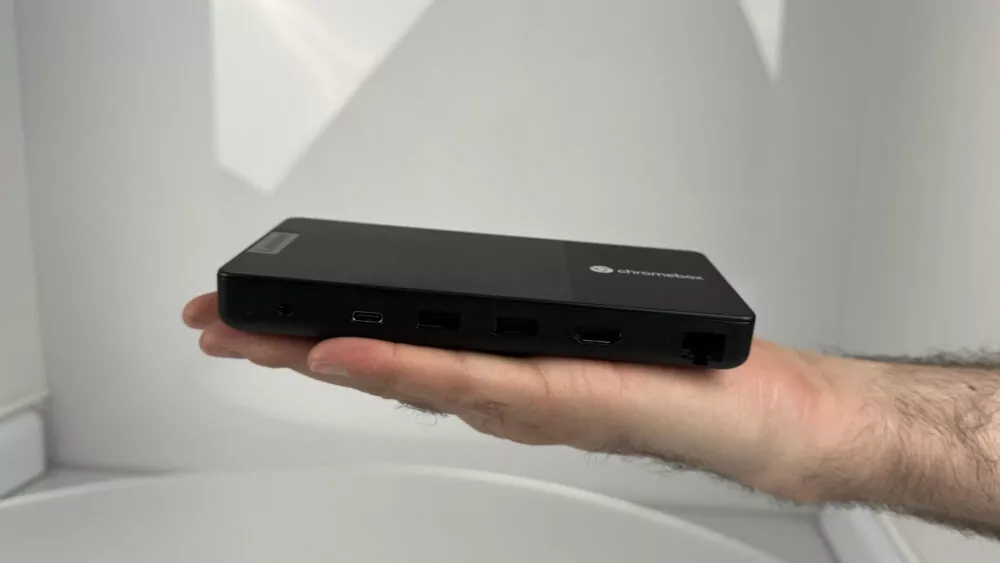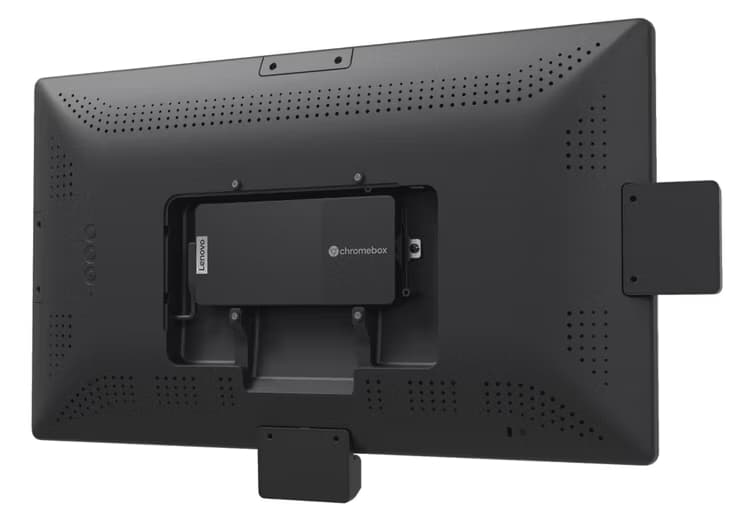Following in the footsteps of the old Chromebit devices, the Lenovo Chromebox Micro was announced on Monday. The downsized Chromebox Micro is primarily meant for digital signage but it’s a full ChromeOS device in its own right. Lenovo introduced the Chromebox Micro at the Digital Signage Experience (DSE) show in Las Vegas.

While consumer and enterprise Chromebooks have ranged in performance up to powerful computers, the Lenovo Chromebox Micro is a little more humble.
Powered by an Intel Celeron N4500, this small computer is paired with 8 GB of memory and 32 GB of local eMMC storage. Additional storage capacity is available through a micro SD card slot. The Chromebox Micro also includes a pair of both USB Type-C and USB Type-A ports, full HDMI, Ethernet, and an audio jack. This Chromebox can drive up to a pair of 4K displays
Ok, that sounds like the specs for an entry-level Chromebook, right? And they are. Remember though that the Lenovo Chromebox Micro is purpose-built for digital signage powered by ChromeOS.
You don’t need tons of processing power, for example, to show digital displays. And you don’t have to pay that much for the capabilities either: Lenovo expects the fanless Chromebox Micro to cost $219.
Just from the news itself, I’m intrigued by the Lenovo Chromebox Micro. Mainly because of the size, which is 6.4 x 3.1 x 0.8 inches (163 x 79 x 19.7 mm). Think about it: That’s around half the size and volume of a traditional Chromebook.
As a new ChromeOS form factor, I find it interesting. Indeed, I’m very into mini PCs myself, having bought two in 2023.
One is used as a desktop with a 34-inch ultrawide monitor while the other runs as a networked home server. The positive experience with these showed me how good a $299 Chromebox could be with the right internals.
The Lenovo Chromebox Micro doesn’t have those internals but it does cost less. And to be fair, it’s not meant as a consumer device.
That doesn’t make me stop wanting it to be one, particularly if it ever got a boost in the CPU. I don’t mind adding my own keyboard and monitor to a practically invisible computer. In my use case, it actually is because I have the mini PC behind the massive monitor. Of course, the Lenovo Chromebox Micro can be out of sight as well by attaching it behind a screen with the mounted screw holes.

Lenovo is actually using that mounting solution to its advantage with a pair of monitors from Instorescreen made specifically to house the Chromebox Micro. I suspect most of these small Chromeboxes will be attached to larger displays but I like the clever holding area of these screens.
There’s little chance you or I will be able to purchase a Lenovo Chromebox Micro, although it might be possible in the future. What do you think of this ChromeOS device and, more importantly, the form factor and potential capabilities?


6 Comments
“As a new ChromeOS form factor”
Not quite. Chromeboxes go back to 2012. In 2014, Google began hyping them as video conferencing devices – Chromebox for Meetings – for their Google Workspace enterprise users. There were even ARM (Qualcomm Snapdragon and Samsung Exynos) Chromeboxes that provided LTE connectivity. (Sadly, this was before Google provided Crostini Linux, otherwise they would have made great IoT and edge mobile computing devices.) OEMs stopped making them because Google essetially stopped allowing ARM ChromeOS devices to be made, especially chips with integrated mobile radios that are also used in smartphones. You can’t use a smartphone chip to build a Chromebox to this day. If you could, that is precisely what this device would have instead of being stuck with a dual core Celeron chip.
Right, Chromeboxes have been around for a decade. But they’ve been roughly the same size and shape as most mini PCs, namely short boxy things. This is a micro version of that design, which I’m my mind is a new form factor. Yes, it’s still a Chromebox, but it looks like no other existing one. ????
Once upon a time, I had a tiny Asus Chromebit CS-10. Remember it? I hope that they’ll refresh it someday with USB-C. No fan means that the CPU can’t be too beefy. But Celeron and Arm chips are always getting more efficient.
A friend of mine has a small retail clinic locally doing medical services. He runs 3 PCs running windows and Chrome browsers. He is (rightfully) getting fed up with all the changes (23H2 etc etc), keeping up with group policies and different staff, user accounts, security, M365 changes and updates and more with Windows – even paying for it all. Everything he does is in a browser – the medical services platform, online booking, Workspace docs and some background browsing. 3 of these would be ideal. They can be secured in a small ventilated metal box – he always has concerns about dodgy staff trying to access and export patient data via USB keys. A product like this would just work for him.
As a Chromebox owner I’m a big fan of the small desktop form factor, and this is smaller again. If they were to put a more powerful processor and maybe a fan if necessary this would be the sort of device I’d consider buying.
I think if I needed something small for a desktop solution, I might consider this, but I would probably want one of the larger chromeboxes with a beefier CPU and more memory & storage.